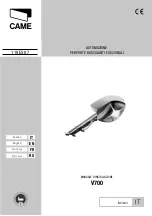
811
Thermo E+ 120/200/320
8 Repairs
8.16 Start-up after burner head or heater
installation
The fuel system must be bleeded after burner installation.
The coolant circuit and the fuel system must be bleeded
after heater installation.
In this process the vehicle manufacturer specifications
must be observed.
Coolant and fuel connections must be checked for leak-
tightness and tight fit during the test run.
If a malfunction occurs during heater operation, troubles-
hooting must be performed (see chapter
8.16.1 Bleeding the fuel system
The whole fuel supply system including the fuel filter must
completely filled with fuel before initial start-up.
Bleeding is particularly important for the operation of
heaters in a single-pipe system. The bleeding procedure
is described in the documentation for the single-pipe kit.
Valeo recommends the usage ofa separate bleeding unit.
Follow the appropriate instructions provided by the
vehicle manufacturer. Verify the fuel supplied to the
heater is bubble-free.
ATTENTION:
The fuel pump must not be used to fill / bleed the fuel
system!
ATTENTION:
In the event no fuel comes to the fuel pump during
initial start-up (dry running), there is a risk that the
fuel pump will be damaged!
8.16.2 Bleeding of the coolant circuit
NOTE:
The coolant circuit must be principally bleeded according
to the manufacturer specification.
Risk of scalds if coolant temperature is increased.
The Aquavent 5000 (U4814) and Aquavent 6000S
(U4855) circulating pumps may only be switched on for
bleeding, after dry operation can be excluded.
The Aquavent 5000S (U4854) and Aquavent 6000SC
(U4856) circulating pumps may even in dry operation be
switched on for bleeding.
Adjust the vehicle heating system to "warm" and refill
coolant.
As soon as it is confirmed that the vehicle engine is filled
with coolant, run vehicle engine with increased idle speed.
Once the cooler thermostat opens, switch the vehicle
engine off and check the coolant level. Refill coolant as
needed.
While the vehicle engine is switched off, switch on the
heater with the circulating pump and the vehicle heating
fan. After the engine motor cooled down, the heater must
automatically start and stop as soon as the upper swit-
ching threshold is reached.
If the heater does not start automatically, it must be veri-
fied, whether the heater overheating protection is trigge-
red and the heater is in fault-lockout state.
) and repeat the bleeding
process.
Risk of scalds!
Caution!
Summary of Contents for Thermo E+ 120
Page 64: ...memos...








































